Something old, something new: corsets for the 21st century
Varsity Fashion talks to student Flora Sharp about her incredible custom-made corset designs
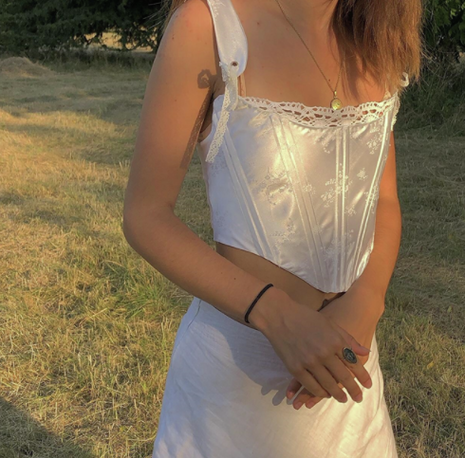
Flora Sharp (or @floramaeart on Instagram) is part-time second year History of Art student, part-time corset extraordinaire. This week, we caught up with her to talk all things fabric, feminism, and flair.
Varsity: This is an incredible and ambitious creative project, when and how did you start it?
Flora: I had wanted to take up sewing for years, but it was only during lockdown that I decided that this was the perfect time to get into it. In April, I saw a tutorial on Pinterest showing how you can use zip ties as corset boning which was much simpler than I would ever have thought and I loved the idea! I borrowed my mum’s sewing machine and gave it a go, trying to work out the rough measurements of a pattern that might fit me. Even though my first attempt was pretty shabby to say the least, it gave me the confidence to start experimenting with my own patterns and shapes. Over April and May, I was working on developing designs almost every day until I got the patterns just right, which was challenging, but so fun. It was only in June that I really started to think about making corsets for other people, and I began selling corsets as a way of raising money for bail funds in the US in support of BLM protests, and donated all profits to these causes. During June and July, I made over thirty corsets in total, which made such a difference to my technique, but also my ambition with what I could do with this hobby.
V: Why corsets?
F: My mum has really inspired my love of historical dress, as she collected lots of antique clothing when she was my age, which include some Victorian corsets. She first showed me her collection when I was sixteen, and I remember being so in awe of how beautiful and elegant they were, and feeling amazing when I tried them on. I think they’re just so effortlessly beautiful, and I personally feel so confident when I wear one. I guess because they’re so dramatically different from every-day clothing, they feel like such a special thing to wear. Historically, they were so constrictive and oppressive for women, and this is something I wanted to change in my designs. I wanted to make corsets which are comfortable and allow you to be mobile, which zip-ties are great for, as they are plastic and very bendable in comparison with corsets from the nineteenth century, for example, which would use very rigid whalebone. I also wanted to be able to customise a corset design which was more casual and could be dressed down and worn with jeans, or dressed up with a big dress to look more dramatic. By making my own corsets, I could choose the length, style, size and fabric of the item, translating historical designs into current tastes. So for me, the idea of corsets came from my own fascination with them for years, but also my wanting to alter them to incorporate a modern influence.
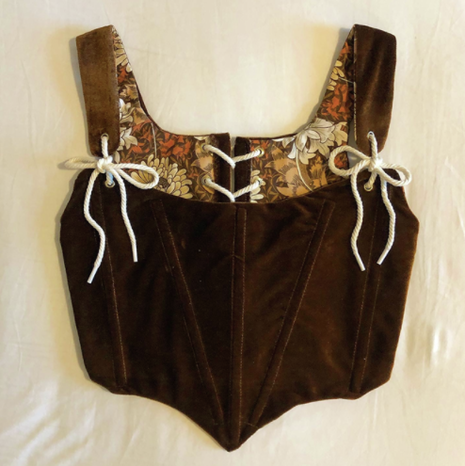
V: How would you describe the aesthetic of your designs and items?
F: Many of my corset designs are dictated by the fabrics I’m using, as I like to use second-hand material, and see what I think would work well as a design from there. A lot of my fabrics are given to me by my grandmother, particularly a lot of William Morris fabric, as she has always loved his designs and has collected a lot throughout her life. So when I use these fabrics, there is definitely an element of sentimentality in my designs because of her. I love knowing that I have given new life to something that was previously a curtain or a cushion cover, and that the fabric is getting new use as a corset. Because of the nature of my second-hand material, it’s hard to pinpoint one common aesthetic that summarises every corset I make. However, I think the shapes of the corsets themselves all have a certain aesthetic of being fashionable and wearable yet still adhering to the spirit of historical dress. I like to keep some traditional corset features such as a laced back, structured boning, eyelet holes, and a V-shape hemline, but still modernise the design in some ways. I have cropped the traditional length of the corset which would go down to the hips, so it instead sits on the waist and essentially acts more like a top than a bustier. I also wanted to be able to incorporate interesting fabrics which you don’t see in historical designs, such as velvets, woven fabrics, taffeta, or denim. I also think that my personal style really influences the aesthetics of my designs. I recognised, when seeing corsets in books, films or even on more recent runways, that they almost always lend themselves to feminine styling, and I wanted to make corsets which were edgier and could be more androgynous. Therefore, I don’t use a lot of lace, or ‘feminine’ colour palettes. Instead, I like choosing fabrics which I think will look effective as a striking corset, rather than to specifically choose a ‘feminine corset aesthetic’. I love knowing that I can wear a black denim corset with some black baggy jeans and still feel as empowered as when I am wearing one of my mum’s Victorian corsets with a skirt and blouse.
“I love knowing that I have given new life to something that was previously a curtain or a cushion cover”
V: To what extent does art history influence your designs?
F: Because of my introduction to corsets through my mum’s antique collection, my interest in corsets is rooted in a fascination with fashion history. I adore looking through patterns from eighteenth and nineteenth century corsets specifically, as there are endless designs and patterns for corsets, many of which are so inventive! Mandy Barrington’s book Stays and Corsets: Historical Patterns Translated for the Modern Body is great - it gives a very comprehensive survey of historical patterns and diagrams, from the early eighteenth century to the late nineteenth century, but it also translates these historical patterns into measurements which the modern reader can attempt. I was inspired by the incorporation of straps in a design from 1776, and took this method into my own work, where straps come over the shoulder from the back and attach to the neckline at either side, using cord which matches the lacing at the back, to tie the whole design together. Not only is this a practical addition to my own design as it makes the corset top feel more secure, but it also reinforced my ambition to combine historical corset features with modern, wearable adaptations. I have recently also collaborated with my friend, Sophie Beckingham, on a series of art-inspired painted corset designs. I create a white corset in a thick, canvas-like material, and she paints scenes inspired by artists or art historical movements using a combination of acrylics, liquitex sealant and oils. So far, we have made three: one inspired by Turner, one by Monet, and one by both Caravaggio and Gentileschi, and are currently working on new commissions, including one inspired by Cézanne and Nash. This has been such an exciting project in incorporating art into my corsets, and collaborating with a very talented friend.
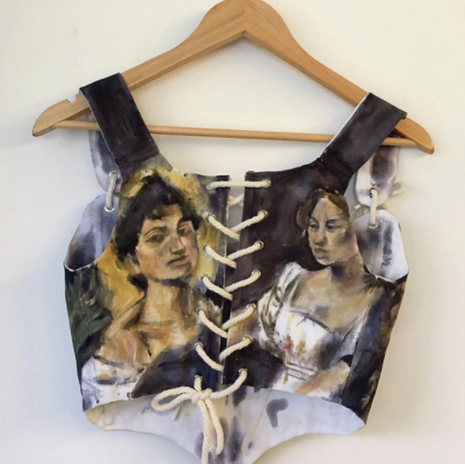
V: Where else do you find inspiration?
F: I can’t talk about my inspiration without mentioning Vivienne Westwood - her corsets are so iconic, and unbelievably beautiful, but I also love her approach to corsetry, and think it aligns well with my own feelings about them. She incorporated corsets into a punk aesthetic, reimagining them as a symbol of female power rather than constraint, and empowering women through clothing which was previously an undergarment, but was now a part of high fashion. But I am also inspired by many smaller creators on instagram, such as Rosie Evans (@artrosie on Instagram), who makes one-off corsets out of vintage material and second-hand textiles, and Aimee Belle Johnson (@immorallondon on Instagram), who takes historical corset patterns and adds modern twists in satin ruched busts and jewelled trimmings.
“I don’t use a lot of lace, or ‘feminine’ colour palettes”
V: What is the process of making an item like?
F: I have a folder of patterns I’ve made, which are essentially shapes cut out of newspaper which I trace around when I cut my fabric pieces for a corset. For each pattern, I have a few different sizes, which I use as a starting point and then alter based on the specific measurements of the person who the corset is for. Once I have all my pieces cut out, I attach all the lining pieces together, i.e. the front piece, two back pieces and two straps, and do the same for the outer material. I then sew the lining and the outer material together, right sides together, on the top and bottom, leaving the back open at each side. This allows me to turn the whole corset the right way out, and insert and sew each piece of boning in the correct position. Finally, I can sew the backs up, add eyelet holes, lace the corset up with cord, and add a hand-sewn label. If I have multiple orders in the same fabric, I will do multiple corsets at a time, as it saves time when doing each stage of the process. This means it can be hard to track how long one corset takes, but usually if I work on one corset from scratch, I can finish it in 3-4 hours, I’d say! It’s such a rewarding process, and I love the final stages when I can see the corset coming together, especially getting to lace up the corset right at the end - that’s definitely my favourite part.
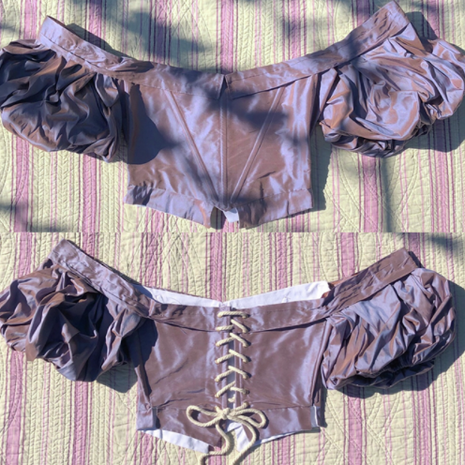
V: Your corsets are made to order, how does this speak to - and how has this influenced - your approach to diversity, accessibility and inclusivity in fashion?
F: It’s so important to me to be able to make my designs as inclusive as possible - I think corsets are amazing for this reason as each one is adjustable so they are less intimidating to buy, as they fit a range of sizes already. I am constantly making new patterns, and developing different sizes which can be adapted for anyone. I found this difficult at first, as I only had myself for reference, but as I gained more practice, and more feedback, I was able to become more precise in my sizings. With fast fashion, there is such an issue already not only with limited ranges of sizings, but also with sizings themselves fluctuating between brands. Therefore, in my work I have made a conscious effort to be tentative about using specific sizings like ‘12’ or ‘14’ and instead I like to work with direct measurements as this is not only objective and precise, but it also removes much of the issue which comes with sizings in fast fashion brands. I want to be able to make a corset for anyone who wants one!
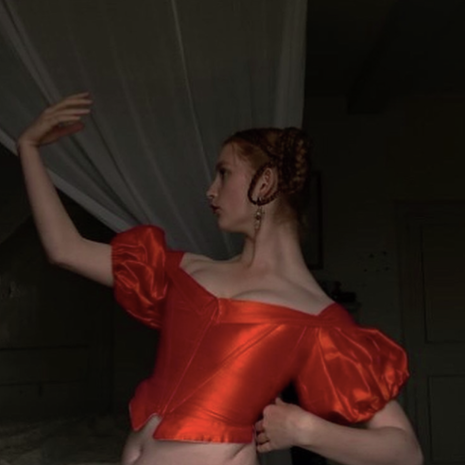
V: Do you have a favourite piece that you’ve made? What makes it special?
F: In September, I was commissioned to make an orange taffeta corset inspired by the Galliano SS93 collection, which was such an amazing challenge as I had to make a corset from scratch, without any pattern pieces, just from inspiration photos. The Galliano collection featured lots of beautiful dramatic puffy sleeves, which I had never made before. I drew some designs, and we discussed a few alterations until we got the perfect design. I then produced two mock-ups to test out the material and the way the design sat on my body, and made a few more alterations. The final piece took me about a week of intermittent sewing to complete, and I was so proud of the result, as it really proved to me how much my sewing had improved since April, as well as my confidence. I think this was the point that I became confident enough to try more extravagant designs and generally just be more ambitious with what designs I could create!
V: Finally, how can readers commission an item from you?
F: My Instagram is @floramaeart, and I take commissions through DM. Sophie Beckingham’s Instagram is @sophiebeckingham.art, we take commissions for painted art corsets through either of our DMs!
 Comment / Plastic pubs: the problem with Cambridge alehouses 5 January 2026
Comment / Plastic pubs: the problem with Cambridge alehouses 5 January 2026 News / Cambridge businesses concerned infrastructure delays will hurt growth5 January 2026
News / Cambridge businesses concerned infrastructure delays will hurt growth5 January 2026 News / New movement ‘Cambridge is Chopped’ launched to fight against hate crime7 January 2026
News / New movement ‘Cambridge is Chopped’ launched to fight against hate crime7 January 2026 News / AstraZeneca sues for £32 million over faulty construction at Cambridge Campus31 December 2025
News / AstraZeneca sues for £32 million over faulty construction at Cambridge Campus31 December 2025 Interviews / You don’t need to peak at Cambridge, says Robin Harding31 December 2025
Interviews / You don’t need to peak at Cambridge, says Robin Harding31 December 2025









